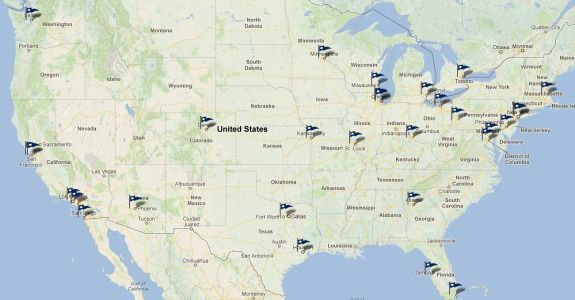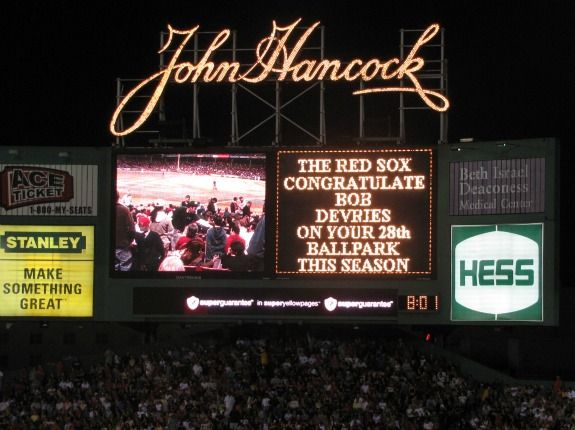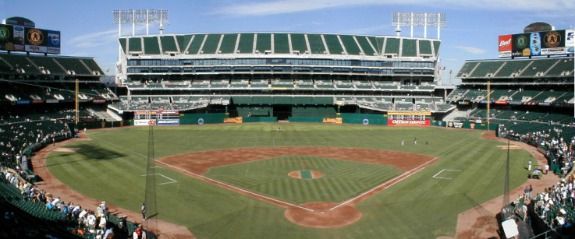Inside the Great American Baseball Road Trip
Forget loyalty. In 2013, it’s all about the stadium, as ballpark chasers take to the road with the goal of seeing a game in every stadium on the continent
/https://tf-cmsv2-smithsonianmag-media.s3.amazonaws.com/filer/20130412101207BaseballPNC2.jpg)
As 2013′s Major League Baseball season begins, that sage advice from the cornfield whispers truer than ever: If you build it, he (or she) will come.
The cross-country stadium hunter, that is. There are thousands of them, traveling city to city, spending their summers and their money on the road with the fanatic’s goal of visiting as many as they can of North America’s 30 Major League Baseball stadiums. Some ballpark chasers, as they’re often called, manage the grand slam of the stadium hunt—hitting all the parks in a single season. Those more ambitious have aimed for doing the tour in one month or less.
But most chasers devote their lifetimes to the pursuit, as Craig Landgren is doing. The 32-year-old Cincinnati Reds fan lives near Seattle, has visited 14 active stadiums and aims to see the rest in coming decades. Landgren is also the founder of BallparkChasers.com, an online community base for baseball fans with a penchant as much for stadiums as the game itself. He launched the website and the organization almost five years ago.
“I kept meeting people who had the same goal as me, to visit all 30 of the stadiums,” Landgren told Off the Road. “I decided there should be a community for this.”
Today, there is. BallparkChasers.com has 1,500 members. They use the site as a resource for tips and suggestions on how to most efficiently and most enjoyably make the Can-American stadium tour—including hotel and restaurant suggestions for each city and suggested multi-stadium weekend routes. Members also use the site as a social networking tool for meeting other ballpark chasers, often at games. Many ballpark chasers have become pen pals. Others have become best friends. Some are baseball newbies, while others have seen hundreds and hundreds of games.

For a few especially ambitious chasers, the pastime is not just a goal but a race—and among these people, records are kept. One member of BallparkChasers.com, for instance, named Josh Robbins, holds the so-called “land record,” having visited every stadium in 26 days without traveling by air—an achievement made especially difficult by such outlying baseball cities as Miami, Phoenix, the San Francisco Bay Area and, especially, Seattle. Another member, Chuck Booth, holds the all-around fastest record of 23 days—several of these, obviously, doubleheaders. Booth describes the journey in his book The Fastest Thirty Ballgames: A Ballpark Chasers (sic) World Record Story, which he co-authored with Landgren.
Another stadium-hunting baseball fanatic, from Annapolis, Maryland, plans to ride a bicycle to every park in the country. Jacob Landis, 23, left home several days ago and will be pedaling the entire 10,500-mile stadium circuit, with van support. The journey may take 175 days.
Roberto Coquis and Judy Pino completed the stadium tour in 2009 with their months-old baby, Sofia.

Bob DeVries, of McHenry, Illinois, became a ballpark chaser in 2009. DeVries lost his wife, Shawn Marie, to a heart condition called arrhythmogenic right ventricular dysplasia in 2008 when she was 35. In 2009, DeVries spent all spring and summer touring the nation, visiting every stadium by September 6, four days before the anniversary of Shawn Marie’s passing. It was a way of keeping himself busy and focused while distracting himself from the alone time he suddenly had to face each weekend, DeVries, 49, told Off the Road. In 2010, the Cubs fan repeated the journey—this time with media coverage and a fund-raising effort for SADS.org, an organization dedicated to understanding and preventing heart-related deaths like that of Shawn Marie.
DeVries says the stadium tour cost him between $17,000 and $20,000 each of his two years on the road. He said the easiest region to tackle is the Northeast, where one can feasibly see a game at every stadium in a week. Some regions of the country, meanwhile, must be approached carefully.
“I made sure that the Astros and Rangers were both at home when I went to Texas so I wouldn’t have to go back again later,” he said. “I did the same thing in Florida and in San Francisco.”
Like so many ballpark chasers, DeVries says his favorite stadium in the country is the Giants’ AT&T Park. His least favorite is just several miles away, across San Francisco Bay—the ogreishly named O.co Coliseum. When The New York Times recently scored each park using Yelp ratings, the Toronto’s Rogers Centre came in last (though it’s still the finest Major League park in Canada, no contest) and O.co landed at number 29—the worst-rated stadium in America. High on the list were the historic Fenway Park of the Boston Red Sox—now the oldest active stadium in the Major Leagues—and Wrigley Field of the Chicago Cubs. Oriole Park at Camden Yards—built in 1992 and considered the first of the new wave of American baseball stadiums—came in fifth, while the Pirates’ PNC Park in Pittsburgh was named as the favorite.
Over the past 20 years, the baseball road trip has enjoyed an extreme makeover. Prior to the early 90s, many stadiums were drab and dull, or simply lacking in visitor amenities. Then, the Baltimore Orioles opened Camden Yards. The park was clean and efficient but with a retro brick-and-ivy look that evoked the good old days of classic American baseball. The Orioles had built it, and the fans came. Attendance spiked. Other cities followed suit, and 22 stadiums have since received splurgy makeovers, turning from crusty old venues of aging bleachers and spilled beer underfoot into semi-swanky tourist attractions.
As new stadiums continue to appear through the seasons, even the most accomplished ballpark chasers may find reason to take to to the road again. Currently, there is talk of moving the Oakland Athletics to a new home in San Jose. Some retired stadium hunters, too, will probably retrace old steps when parks receive renovations, which are forever in the works. Still others who have seen every active park, according to Landgren, make it a goal to repeat the feat, this time seeing their favorite team—not just any teams—play in each stadium. Some are looking to expand the chase into Japan, where Major League games have been played. A few look to an entirely other level—the Minor Leagues—and begin a whole new hunt in a land of smaller crowds, cheaper seats and players who aren’t millionaires.
The ballpark chase goes on.

Tips for the Tour: Following are a few suggestions for how to make the stadium tour (no skipping Toronto, Seattle or Miami!) at minimal cost and stress and with minimal backtracking.
Beware of rainouts. If you must race onward from a rained out game in order to catch other games for which you’ve already bought tickets, you will be forced to return later for another try. A rainout in Colorado could potentially be devastating for your summertime stadium tour.
If you’re driving, rent a hybrid car and reduce your gas costs.
When possible, visit two stadiums in a day. This will buy you time for later down the road.
For places with multiple teams within a small region, like Florida, the San Francisco Bay Area, Southern California and the Northeast, try and visit when each club is in town.
Camp. It’s cheaper than sleeping in hotels.
Don’t go too fast, and save time to see the highlights of each city. This may be the only time you’ll visit them.
/https://tf-cmsv2-smithsonianmag-media.s3.amazonaws.com/accounts/headshot/Off-Road-alastair-bland-240.jpg)
/https://tf-cmsv2-smithsonianmag-media.s3.amazonaws.com/accounts/headshot/Off-Road-alastair-bland-240.jpg)